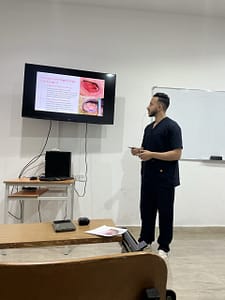Teaching and Learning Strategies
PBL (Problem-based learning )
Problem-based learning is the centerpiece of the new and improved teaching and learning technique being implemented at the Libyan International Medical University. It is a technique that is primarily centered on integrating different medical sciences at the same school level. The various stages of the educational process are broken down into units of instruction, each of which contains a number of educational conundrums, each of which addresses a variety of educational goals from different scientific fields. These goals are addressed through panel discussions, interactive lectures, hands-on activities, and scientific seminars.
Team-based Learning TBL
- Team-based learning (TBL) combines problem-based and case-based learning. Its exercises require teams to pick an answer and defend it against other teams’ solutions. Team-based learning engages students in workplace situations to improve active learning and critical thinking. Its active-interactive nature led the faculty to incorporate it in some of its advanced courses. In TBL courses:
- Students are distributed into small groups that do not exceed 7 students in a group for the course.
- Students independently look at the case study at hand, read the prepared material, references, and related books, and then discuss their results and conclusions with each other.
- This discussion should be done under the direct supervision of the instructors. The role of the instructor is limited to clarifying any misunderstanding whenever that was necessary.
- The instructor is recommended to give short talks when there is a need to do so. In the same context, students also evaluate their answers and present their work in group discussions in the presence of the instructors. Students need to discuss their arguments as well.
Team-Based Learning is very useful in building many transferable skills such as the spirit of lifelong self-learning, self-reliance, the culture of dialogue, accepting constructive criticisms, and defending opinions with evidence and argument.
The flipped classroom
The flipped classroom is a learner-centered pedagogical approach that inverts the traditional model of teaching by delivering instructional content online outside of class time and using face-to-face sessions for active learning, problem-solving, and clinical application. This method is particularly effective in medical and health sciences education, where students need to apply theoretical knowledge to real-life clinical scenarios.






PBL Sessions
hey consist of a small group of students, 12 or less, and a tutor. Students stay with the same group for the entire duration of the semester. The first session is the Brainstorming session, while the second one is the Debriefing session



What Students Say About the Nursing Sciences Program
Nursing at the International University
Meeting Global Standards
student Hannibal shares why he chose the nursing path and how the International University offers a high-quality learning environment that meets global standards—preparing him to be a key contributor to the future of healthcare.
Student Experience
Batool shares her inspiring journey through the first year of the Nursing Program at the International University. Her story highlights the challenges, personal growth, and valuable experiences that define student life in the program.
Team-based Learning TBL
TBL has three main stages: students prepare the material in advance, take an individual and team quiz in small groups, then apply what they learned by discussing real-life problems or cases. This method builds teamwork skills, deep understanding, and connects theory to practice.





E-learning
E-Learning changed traditional chalk and board education. It revolutionized the teaching and learning process; internet-delivered courses outside of the classroom helped in simplifying, multiplying, and improving the giving and receiving of information.
By using E-learning tools, teaching, and learning become simpler, easier, and more successful. The faculty uses Zoom, Google Meet, and Microsoft Office packages as tools in its E-Learning journey. Lectures are sometimes recorded and then displayed on both the university’s YouTube channel and the university’s Moodle. The faculty also displays the scientific production of its students and faculty members on the digital repository and makes it available to its beneficiaries inside or outside the university.
The Program’s Digital Repository is an open-access institutional repository created to preserve students’ research work. The repository supports teaching and lifelong learning within the campus. Publishing these works on the DR increases the openness of the faculty to both the local and international environment.
It is one of the most popular learning management systems that is being adopted by many educational institutions around the world. It helps facilitate E-Learning. It is user-friendly. It helps engage students more in the learning process
The School of Health and Medical Sciences uses many of the Moodle features in an attempt to improve its educational process. Instructors upload E-Books, and weekly lectures in different formats such as Word, PowerPoint, and Excel. They can also share presentations, videos, and links to other educational websites that they feel are beneficial for their students. Moodle also provides a forum that brings the students together with their instructors for scientific dialogue on the course topics. Additionally, instructors can also write announcements for the course’s registered students using Moodle. Finally, it aids the instructors in conducting quizzes, assignments, and periodic and final exams
